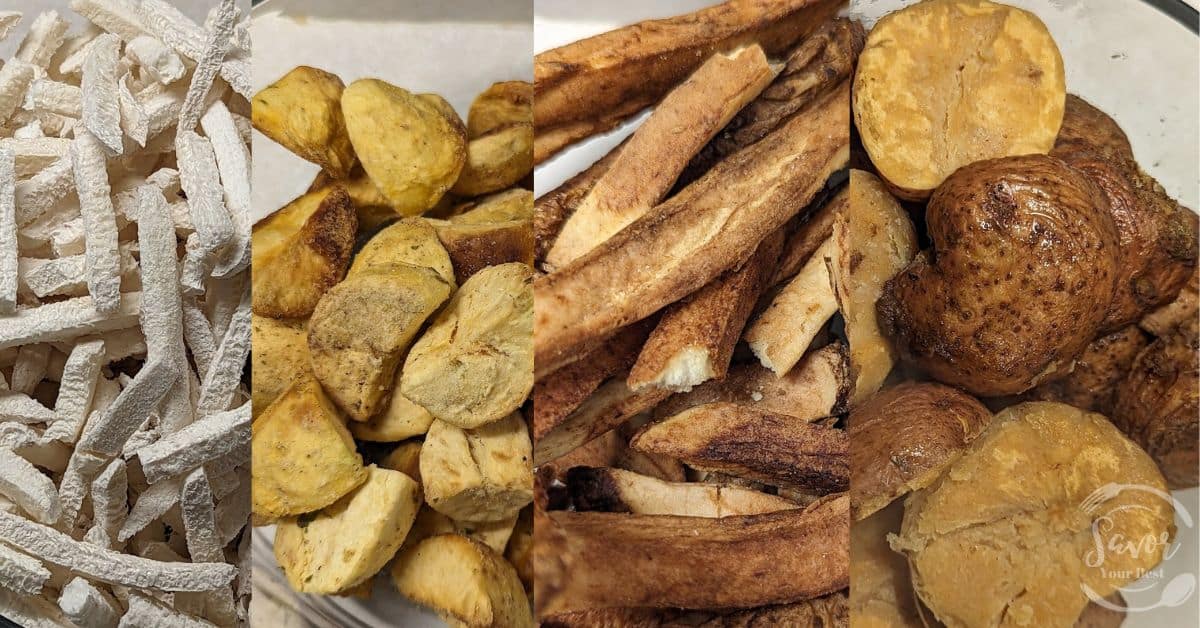Potatoes are a staple in many kitchens because of their versatility and broad appeal. You can enjoy this beloved root vegetable in various forms by freeze drying them whenever you like. This process not only saves time and money but also helps in reducing food waste. Let’s learn how to freeze dry potatoes, covering everything from preparation to rehydration tips.
What is Freeze Drying?
Freeze drying, also known as lyophilization, is a preservation process that removes moisture from a product after it’s been frozen. The key to freeze drying is a phenomenon called sublimation, where water transitions directly from a solid (ice) to a gas (vapor) without passing through a liquid phase.
This process begins by freezing the food, then placing it in a vacuum, allowing the ice to vaporize and escape. This removal of moisture preserves the food’s structure, nutritional value, and flavor more effectively than traditional drying methods. The resulting product is lightweight, has an extended shelf life, and can be easily rehydrated to nearly its original state. Freeze drying is popular for preserving a wide range of foods, from fruits and vegetables to meats and complete meals, making it a favorite technique in both commercial food production and home food preservation.
Check out our article about the Best Freeze Dryers to find the best machine for your needs.
Save Time and Money by Freeze Drying Potatoes
Freeze drying potatoes not only enhances your culinary flexibility but also contributes to a more sustainable and economical kitchen routine.
Bulk Preparation: Time-Saving in Meal Prep
- Planning Ahead: By freeze drying large batches of potatoes, you’re preparing multiple meals in advance. This foresight can significantly reduce the daily time spent on meal preparation.
- Convenience for Busy Schedules: For those with hectic lifestyles, having freeze dried ingredients ready to go means quicker meal assembly, especially on busy weeknights or unexpected busy days.
- Cook Once, Eat Many Times: By cooking and freeze drying in bulk, you transform a single cooking session into multiple future meals, maximizing your time and effort in the kitchen.
Long Shelf Life: Reducing Waste and Saving Money
- Extended Preservation: Freeze dried potatoes can last for years without significant loss in quality, taste, or nutritional value, as opposed to fresh potatoes, which have a much shorter shelf life and are prone to spoiling.
- Economical: Over time, storing and using potatoes as needed leads to less food waste and more efficient use of your grocery budget.
- Emergency Readiness: The long shelf life also makes freeze dried potatoes an ideal component of emergency food supplies, ensuring you have access to essential nutrients during unforeseen circumstances.
Versatility: Ready for Any Meal
- Diverse Culinary Uses: With various types of freeze dried potatoes (like mashed, roasted, or fried) at your disposal, you can quickly adapt to different recipes and meal ideas.
- Spontaneous Cooking: The versatility of freeze dried potatoes means you can spontaneously create meals without being limited by what’s fresh in your pantry or fridge.
- Seasonal Independence: Freeze drying allows you to enjoy potato-based dishes year-round, irrespective of the seasonal availability of fresh potatoes.
Energy Efficiency: Smarter Cooking Practices
- Reduced Cooking Frequency: By preparing and freeze drying potatoes in large quantities, you minimize the need to cook frequently, which can save on energy costs over time.
- Optimized Appliance Use: Using a freeze dryer to its full capacity for large batches is more energy-efficient than running it for smaller amounts. Similarly, cooking large batches of potatoes at once is more energy-efficient than doing so in multiple, smaller batches.
- Long-Term Savings: Although the initial investment in a freeze dryer and the energy to run it might seem substantial, the long-term savings from reduced food waste, fewer grocery trips, and lower energy bills for daily cooking can be significant.
Freeze drying is not only for potatoes. You can get these benefits for many ingredients in your pantry. See our article about the Best Vegetables to Freeze Dry.
Preparing the Potatoes for Freeze Drying
The preparation of potatoes for freeze drying is as crucial as the freeze drying process itself. By selecting the best potatoes and preparing them correctly, you ensure a high-quality, enjoyable product when rehydrated and used in your favorite recipes.
Regardless of the type of potato or cooking method, the first step is always preparation:
Choosing the Best Potatoes
Before diving into preparation, selecting high-quality potatoes is crucial for the best freeze-drying results. Here are some tips:
Variety Matters
Choose the correct type of potato based on your intended use. There are many varieties of potatoes, each with unique characteristics. For instance, Russets are great for baking and frying, while Yukon Golds are ideal for mashing.
Look for Freshness
Fresh potatoes should be firm, smooth, and free of sprouts, green spots, or extensive blemishes.
Avoid Moisture
Potatoes with a high moisture content (like new potatoes) may not freeze dry as well. Opt for starchy varieties for better results.
Why Quality is Important
Texture and Flavor Preservation
High-quality potatoes will retain their texture and flavor better through the freeze drying process, ensuring a more enjoyable end product.
Longer Shelf Life
Better quality potatoes will freeze-dry more effectively and are less likely to spoil, leading to a longer shelf life.
Nutritional Value
Healthy, high-quality potatoes are richer in nutrients, which are preserved in the freeze drying process.
Step 1: Cleaning
- Rinse Thoroughly: Run the potatoes under cold water to remove any surface dirt. Use a vegetable brush for a more thorough cleaning, especially if you plan to keep the skin on.
- Dry Completely: After washing, pat the potatoes dry with a clean towel. This step is essential to avoid any steam or moisture build-up during cooking, which can affect the freeze-drying process.
Step 2: Peeling (Optional)

- To Peel or Not to Peel: The decision to peel potatoes depends on the dish you’re making and personal preference. For example, keep the skin on for rustic dishes like roasted potatoes to add texture and nutrients, or peel them for a smoother texture in mashed potatoes.
- Peeling Technique: Use a potato peeler or a small knife if peeling. Try to remove only the thin outer layer to minimize waste.
Step 3: Cutting
- Consistent Size and Shape: Cut the potatoes into uniform pieces for even cooking and freeze-drying. For example, dice for soups, slice for casseroles, or leave whole for baking.
- Avoid Browning: If you won’t cook or freeze dry them immediately, keep the cut potatoes in water to prevent browning. This is especially important for raw potatoes.
Freeze Drying Different Types of Potatoes
Raw Potatoes

- Slice or Dice: Begin by cutting the raw potatoes into uniform pieces. The size and shape depend on how you plan to use them later. Smaller, even pieces ensure a consistent freeze drying process.
- Blanching (Optional): Blanching is an optional step, but it’s beneficial for preserving the color and texture of the potatoes. It involves briefly boiling the potatoes and then plunging them into ice water. This process also helps inactivate enzymes that can cause spoilage.
- Freeze Drying: Arrange the blanched or raw potato pieces on the freeze dryer trays in a single layer. Ensure they are spaced out to allow for efficient freeze drying. The freeze drying process will remove all the moisture, preserving the potatoes for long-term storage.
Fried French Fries and Wedges
- Cook: Fry the potato cuts (either as fries or wedges) until they achieve a golden, crispy texture. The key here is to get a good external crispness while keeping the inside tender.
- Cooling: After frying, let them cool down to room temperature. This step is essential to prevent condensation during the freeze drying process.
- Freeze Drying: Once cooled, place the fries or wedges on the freeze dryer trays. Start the freeze drying cycle, which will lock in the texture and flavor, making them easy to rehydrate and enjoy later.
Roasted Potatoes

- Roasting: Season the potatoes with your preferred herbs, spices, and a bit of oil, then roast them until they’re perfectly cooked. You can choose various flavors, from simple salt and pepper to elaborate spice mixes.
- Cool Down: Let the roasted potatoes cool to room temperature. They must be completely cooled to ensure the freeze drying process is effective.
- Freeze Drying: Lay the roasted potatoes on the freeze dryer trays, ensuring they do not touch. Freeze drying will preserve their roasted flavor and texture.
Mashed Potatoes
- Prepare: Whip up your mashed potatoes as you usually would. You might opt for a smoother texture as it freeze-dries more evenly.
- Spreading: Spread the mashed potatoes in a thin, even layer on the freeze dryer trays. Avoid making the layer too thick to ensure uniform drying.
- Freeze Drying: Proceed with the freeze drying process until the mashed potatoes are completely dry. They can be rehydrated later for a quick and easy side dish.
Potatoes with Brown Gravy
- Cooking: Cook the potatoes to your preferred style, and prepare the brown gravy separately. The consistency of the gravy should not be too thin to prevent it from seeping too much into the potatoes during freeze drying.
- Combining: Once both components are ready and cooled, combine them. You can mix them thoroughly or layer them in the tray, depending on how you wish to enjoy them later.
- Freeze Drying: Freeze drying this combination will preserve the dish’s unique flavor, allowing you to enjoy a classic meal with minimal preparation later on.
Packaging Freeze Dried Potatoes for Optimal Preservation
Proper packaging is crucial for maintaining the quality of freeze dried potatoes, whether storing them for the short term or long term. The proper packaging ensures that your potatoes stay dry, flavorful, and nutritious until you’re ready to use them. Here’s a guide to effectively packaging different types of freeze dried potatoes:
Packaging Materials
Airtight Containers
Airtight containers like glass jars or plastic containers with tight-fitting lids work well for short-term storage.
Mylar Bags with Oxygen Absorbers
For long-term storage, Mylar bags with oxygen absorbers are ideal. They protect the potatoes from moisture, light, and air, significantly extending their shelf life.
Vacuum Sealing
Vacuum-sealed bags are another excellent option for long-term storage, especially for bulky items like freeze dried potato wedges or French fries.
Long-Term vs Short-Term Storage
Location
A cool, dry place like a pantry works well for short-term storage. Consider a location with stable, cooler temperatures, like a basement or root cellar, for long-term storage.
Labeling
Always label your packages with the date of freeze drying and the type of potato. This helps in tracking shelf life and in identifying the contents quickly.
Inspect Regularly
For long-term stored items, inspect them periodically to ensure there’s no moisture or damage to the packaging.
Packaging Tips for Different Types of Potatoes

Raw Potatoes
- Minimal Handling: Since raw freeze dried potatoes are more prone to breaking, handle them gently while packaging.
- Small Batches: Consider packaging them in smaller quantities for convenience and to minimize exposure to air and moisture when opened.
Fried French Fries and Wedges
- Avoid Crushing: Use sturdy containers or cushioning materials to prevent the fries or wedges from getting crushed.
- Vacuum Sealing: Vacuum-sealed bags are ideal for maintaining the texture of freeze dried French fries and wedges.
Roasted Potatoes
- Room for Expansion: Leave some space in the packaging to prevent the pieces from compressing and losing their shape.
- Layering: If using Mylar bags, layer the potatoes gently to maximize space and protect their form.
Mashed Potatoes
- Powdered Form: If your freeze dried mashed potatoes are powdered, use a scoop or funnel to pour them into containers or bags to avoid mess.
- Seal Tightly: Ensure the containers or bags are sealed tightly to prevent moisture from clumping the mashed potatoes. Oxygen Absorbers will also help to avoid clumping.
Potatoes with Brown Gravy
- Individual Portions: Package in portion-sized amounts for convenient use. This prevents you from having to rehydrate the entire batch if you only need a small amount.
- Double-Seal for Safety: If using Mylar bags, consider double-sealing the edges for extra protection against moisture.
Rehydrating Freeze Dried Potatoes: Detailed Tips for Every Type
Freeze dried potatoes, once rehydrated, can closely mimic the texture and flavor of their original state. By following these rehydration tips, you can ensure that your freeze dried potatoes retain as much of their original texture and flavor as possible, making them a convenient and tasty addition to any meal.
Raw Potatoes
- Soaking Method: Rehydrate raw potato pieces by soaking them in warm water for about 10-15 minutes. Check for softness; they should regain a texture similar to fresh-cut potatoes.
- Cooking After Rehydration: After soaking, these potatoes can be used as if they were fresh. They’re perfect for dishes where the potato will be cooked further, like in stews, soups, or roasts.
Fried French Fries and Wedges

- Oven or Air Fryer Method: To restore the crispiness of freeze dried French fries or wedges, rehydrate them by lightly spraying them with water and then heating them in an oven or air fryer. The dry heat will help bring back the crunch.
- Time & Temperature: Heat them at a medium-high temperature (about 350°F or 175°C) for a few minutes, checking periodically for the desired crispness.
Roasted Potatoes
- Oven Rehydration: Rehydrate roasted potatoes by placing them in a warm oven. Sprinkle water over them or cover them with foil to add moisture to the potatoes.
- Restoring Flavor: Consider adding a bit of butter or oil and re-seasoning after they’re rehydrated to enhance flavor.
Mashed Potatoes
- Gradual Addition of Liquid: To rehydrate mashed potatoes, add warm milk or water gradually, stirring consistently. The amount of liquid needed may vary, so add slowly until you reach your desired consistency.
- Flavor Enhancement: Feel free to add butter, cream, or additional seasonings after rehydration to bring back the rich flavor of the original mashed potatoes.
Potatoes with Brown Gravy

- Separate Rehydration: It’s often best to rehydrate the potatoes and gravy separately to control their textures. For the potatoes, use the soaking method. For the gravy, add warm water and stir until it reaches the right consistency. Once both components are rehydrated, combine them. You may need to heat them together briefly on the stove to blend the flavors effectively.
- Combined Rehydration: If you freeze dried the potatoes and gravy combined (as I did), place the mixture in a bowl and gradually add warm water, stirring gently. The warm water will slowly rehydrate the potatoes and dissolve the gravy, merging their flavors. Adding water incrementally is essential to avoid making the dish too watery or diluting the taste. Once the mixture reaches the desired consistency, let it sit for a few minutes to absorb the moisture fully. You can adjust the thickness by adding more water or heating it on the stove to evaporate excess liquid.
General Rehydrating Tips
- Water Temperature: Using warm water can speed up the rehydration process without cooking the potatoes further.
- Avoid Over-Soaking: Over-soaking can make the potatoes mushy. Check the texture frequently and remove them from the water once they reach the desired consistency.
- Patience is Key: Some freeze dried potatoes may take longer to rehydrate. Be patient and allow them enough time to absorb the water entirely.
Conclusion
Freeze drying potatoes is an excellent way to preserve their nutrition and flavor, offering convenience and cost savings. Whether prepping for a busy week, planning camping meals, or stocking up your emergency food supply, freeze dried potatoes are a standout ingredient for any well-stocked pantry.
Their versatility, ease of use, and longevity make them an invaluable resource for everyday cooking and long-term food storage.
The ability to transform these potatoes into various forms – from raw to mashed, from French fries to wedges with gravy – speaks to their adaptability in meeting diverse culinary needs. They become an effortless solution for quick meals and a reliable component in emergency food supplies.
The cost-effectiveness of freeze drying large batches minimizes food waste, saves money over time, and ensures a steady supply of a nutritious ingredient.
The ease of rehydration and the preservation of flavor and texture further enhance the appeal of freeze dried potatoes, making them almost indistinguishable from their freshly-cooked counterparts.
Incorporating freeze dried potatoes into your pantry ensures that you have a versatile, nutritious, and ready-to-use ingredient at hand, regardless of the situation. Whether you’re whipping up a quick dinner, planning a camping trip, or stocking up for unforeseen circumstances, freeze dried potatoes stand ready to enrich your meals and simplify your cooking preparation.
Questions? We Have Answers.
Get answers to a list of the most Frequently Asked Questions.




